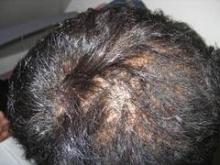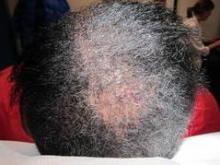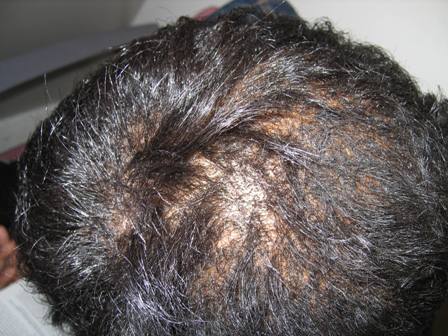User login
NEW YORK – To get to the root cause of hair loss in African American patients, ask them about their chemical styling and physical styling practices, advised Dr. Roopal V. Kundu.
"Ask them about the hair products they use; how they style their hair; what kind of relaxers they use; what kind of heat, how much of it, and how often they use it; and find out if they’re wearing extensions or weaves," she said to a packed room during the American Academy of Dermatology summer meeting.
"And get their hair stylist’s input," said Dr. Kundu, director of the Center for Ethnic Skin at Northwestern University, Chicago.
Central centrifugal cicatricial alopecia (CCCA) is one of the most common types of hair loss in African American women, Dr. Kundu said. The reason for the prevalence of CCCA in this population remains unclear, but data from several studies point not only to genetic and ethnic predispositions, but also to hair styling practices.
Data from one study showed that women with CCCA were significantly more likely to report recent traumatic hairstyling than were those who did not have the condition (J. Am. Acad. Dermatol. 2009;60:574-8).
"Educate your patients [about the effect of hairstyling practices on hair loss] as early as possible," and suspect CCCA in patients who present with a lot of breakage in their hair, even if they have no sign of alopecia or scalp inflammation, Dr. Kundu said.
Keep chemical and physical hairstyling practices in mind when examining and diagnosing hair loss in black women, she noted.
Chemical relaxers, also known as perms, are one of the most common treatments used by African American women. The relaxers are used to loosen tight curls and are applied every 6-8 weeks to new growth only. There are two types of relaxers: lye (professional product) or no lye (at-home use). The lye relaxers have more potential for irritation, Dr. Kundu said.
Physical styling, which usually pulls on hair, also can be a factor in hair loss, she explained. Some popular types of physical styling include:
• Braids, which often involve added synthetic hair and are left in place for weeks to months.
• Twisting, which involves interlocking two pieces of hair to create a loose or bound-down, three-dimensional hair style.
• Cornrows, which are braids that lie flat against the scalp, with or without added hair, that can cause excessive tension on the hair.
• Locks or dreads, which are matted coils of hair.
• Weaves, which can be clipped, glued, or sewn into place.
In addition, thermal styling (with tools such as flatirons) is a popular treatment that can damage the hair because of the high temperature of the iron, Dr. Kundu said.
When examining a skin of color patient who presents with hair loss, note their hairstyle first, Dr. Kundu emphasized. "Ask them to take their hairpiece off [if they are wearing one]. If the hairstyle doesn’t allow you to examine the scalp, the patient needs to come back between hairstyles," she said.
Grab a dermatoscope and examine the scalp, Dr. Kundu said. Look for hair loss, hair breakage, and traction. She cited a recent study suggesting that early CCCA should be considered in the differential diagnosis of these patients (Arch. Dermatol. 2012;148:1047-52).
"And don’t dismiss scalp dysesthesia* in a black woman," Dr. Kundu emphasized. "I really take this to heart," she said.
Biopsy the patient, "and always go for the periphery to see if there is active inflammation," since the central area of hair loss is usually scarred, she noted.
Dr. Kundu said that she usually prescribes potent to superpotent topical steroids, such as fluocinonide daily, and then reduces the steroid to 1-3 times a week for maintenance. She also performs intralesional injections every 6 weeks, and stops if she sees no efficacy after 3-4 serial injections.
When prescribing minoxidil, she advised taking the patient’s facial hair into consideration, and warns them about additional facial hair growth.
For patients with significant inflammation, Dr. Kundu said she first turns to doxycycline (starting at 100 mg twice a day and tapering to anti-inflammatory doses of 50 mg daily) for a total of 3-6 months.
Meanwhile, advise women with hair loss or hair loss concerns to modify their grooming practices to avoid hairstyles that pull on the scalp, she said. Also advise them to let their hair go natural completely for at least a year if possible. "It’s a hard job to do for some patients," she acknowledged, so at least encourage them to apply chemical relaxers less frequently, every 10-12 weeks instead, she said.
In addition, ask these patients to refrain from using heat on their hair more than once or twice per week, and suggest air-drying instead, she said.
Dr. Kundu had no relevant financial conflicts to disclose.
On Twitter @naseemsmiller
*CORRECTION, 10/21/13: An earlier version of this article misstated the effects of dysesthesia.
NEW YORK – To get to the root cause of hair loss in African American patients, ask them about their chemical styling and physical styling practices, advised Dr. Roopal V. Kundu.
"Ask them about the hair products they use; how they style their hair; what kind of relaxers they use; what kind of heat, how much of it, and how often they use it; and find out if they’re wearing extensions or weaves," she said to a packed room during the American Academy of Dermatology summer meeting.
"And get their hair stylist’s input," said Dr. Kundu, director of the Center for Ethnic Skin at Northwestern University, Chicago.
Central centrifugal cicatricial alopecia (CCCA) is one of the most common types of hair loss in African American women, Dr. Kundu said. The reason for the prevalence of CCCA in this population remains unclear, but data from several studies point not only to genetic and ethnic predispositions, but also to hair styling practices.
Data from one study showed that women with CCCA were significantly more likely to report recent traumatic hairstyling than were those who did not have the condition (J. Am. Acad. Dermatol. 2009;60:574-8).
"Educate your patients [about the effect of hairstyling practices on hair loss] as early as possible," and suspect CCCA in patients who present with a lot of breakage in their hair, even if they have no sign of alopecia or scalp inflammation, Dr. Kundu said.
Keep chemical and physical hairstyling practices in mind when examining and diagnosing hair loss in black women, she noted.
Chemical relaxers, also known as perms, are one of the most common treatments used by African American women. The relaxers are used to loosen tight curls and are applied every 6-8 weeks to new growth only. There are two types of relaxers: lye (professional product) or no lye (at-home use). The lye relaxers have more potential for irritation, Dr. Kundu said.
Physical styling, which usually pulls on hair, also can be a factor in hair loss, she explained. Some popular types of physical styling include:
• Braids, which often involve added synthetic hair and are left in place for weeks to months.
• Twisting, which involves interlocking two pieces of hair to create a loose or bound-down, three-dimensional hair style.
• Cornrows, which are braids that lie flat against the scalp, with or without added hair, that can cause excessive tension on the hair.
• Locks or dreads, which are matted coils of hair.
• Weaves, which can be clipped, glued, or sewn into place.
In addition, thermal styling (with tools such as flatirons) is a popular treatment that can damage the hair because of the high temperature of the iron, Dr. Kundu said.
When examining a skin of color patient who presents with hair loss, note their hairstyle first, Dr. Kundu emphasized. "Ask them to take their hairpiece off [if they are wearing one]. If the hairstyle doesn’t allow you to examine the scalp, the patient needs to come back between hairstyles," she said.
Grab a dermatoscope and examine the scalp, Dr. Kundu said. Look for hair loss, hair breakage, and traction. She cited a recent study suggesting that early CCCA should be considered in the differential diagnosis of these patients (Arch. Dermatol. 2012;148:1047-52).
"And don’t dismiss scalp dysesthesia* in a black woman," Dr. Kundu emphasized. "I really take this to heart," she said.
Biopsy the patient, "and always go for the periphery to see if there is active inflammation," since the central area of hair loss is usually scarred, she noted.
Dr. Kundu said that she usually prescribes potent to superpotent topical steroids, such as fluocinonide daily, and then reduces the steroid to 1-3 times a week for maintenance. She also performs intralesional injections every 6 weeks, and stops if she sees no efficacy after 3-4 serial injections.
When prescribing minoxidil, she advised taking the patient’s facial hair into consideration, and warns them about additional facial hair growth.
For patients with significant inflammation, Dr. Kundu said she first turns to doxycycline (starting at 100 mg twice a day and tapering to anti-inflammatory doses of 50 mg daily) for a total of 3-6 months.
Meanwhile, advise women with hair loss or hair loss concerns to modify their grooming practices to avoid hairstyles that pull on the scalp, she said. Also advise them to let their hair go natural completely for at least a year if possible. "It’s a hard job to do for some patients," she acknowledged, so at least encourage them to apply chemical relaxers less frequently, every 10-12 weeks instead, she said.
In addition, ask these patients to refrain from using heat on their hair more than once or twice per week, and suggest air-drying instead, she said.
Dr. Kundu had no relevant financial conflicts to disclose.
On Twitter @naseemsmiller
*CORRECTION, 10/21/13: An earlier version of this article misstated the effects of dysesthesia.
NEW YORK – To get to the root cause of hair loss in African American patients, ask them about their chemical styling and physical styling practices, advised Dr. Roopal V. Kundu.
"Ask them about the hair products they use; how they style their hair; what kind of relaxers they use; what kind of heat, how much of it, and how often they use it; and find out if they’re wearing extensions or weaves," she said to a packed room during the American Academy of Dermatology summer meeting.
"And get their hair stylist’s input," said Dr. Kundu, director of the Center for Ethnic Skin at Northwestern University, Chicago.
Central centrifugal cicatricial alopecia (CCCA) is one of the most common types of hair loss in African American women, Dr. Kundu said. The reason for the prevalence of CCCA in this population remains unclear, but data from several studies point not only to genetic and ethnic predispositions, but also to hair styling practices.
Data from one study showed that women with CCCA were significantly more likely to report recent traumatic hairstyling than were those who did not have the condition (J. Am. Acad. Dermatol. 2009;60:574-8).
"Educate your patients [about the effect of hairstyling practices on hair loss] as early as possible," and suspect CCCA in patients who present with a lot of breakage in their hair, even if they have no sign of alopecia or scalp inflammation, Dr. Kundu said.
Keep chemical and physical hairstyling practices in mind when examining and diagnosing hair loss in black women, she noted.
Chemical relaxers, also known as perms, are one of the most common treatments used by African American women. The relaxers are used to loosen tight curls and are applied every 6-8 weeks to new growth only. There are two types of relaxers: lye (professional product) or no lye (at-home use). The lye relaxers have more potential for irritation, Dr. Kundu said.
Physical styling, which usually pulls on hair, also can be a factor in hair loss, she explained. Some popular types of physical styling include:
• Braids, which often involve added synthetic hair and are left in place for weeks to months.
• Twisting, which involves interlocking two pieces of hair to create a loose or bound-down, three-dimensional hair style.
• Cornrows, which are braids that lie flat against the scalp, with or without added hair, that can cause excessive tension on the hair.
• Locks or dreads, which are matted coils of hair.
• Weaves, which can be clipped, glued, or sewn into place.
In addition, thermal styling (with tools such as flatirons) is a popular treatment that can damage the hair because of the high temperature of the iron, Dr. Kundu said.
When examining a skin of color patient who presents with hair loss, note their hairstyle first, Dr. Kundu emphasized. "Ask them to take their hairpiece off [if they are wearing one]. If the hairstyle doesn’t allow you to examine the scalp, the patient needs to come back between hairstyles," she said.
Grab a dermatoscope and examine the scalp, Dr. Kundu said. Look for hair loss, hair breakage, and traction. She cited a recent study suggesting that early CCCA should be considered in the differential diagnosis of these patients (Arch. Dermatol. 2012;148:1047-52).
"And don’t dismiss scalp dysesthesia* in a black woman," Dr. Kundu emphasized. "I really take this to heart," she said.
Biopsy the patient, "and always go for the periphery to see if there is active inflammation," since the central area of hair loss is usually scarred, she noted.
Dr. Kundu said that she usually prescribes potent to superpotent topical steroids, such as fluocinonide daily, and then reduces the steroid to 1-3 times a week for maintenance. She also performs intralesional injections every 6 weeks, and stops if she sees no efficacy after 3-4 serial injections.
When prescribing minoxidil, she advised taking the patient’s facial hair into consideration, and warns them about additional facial hair growth.
For patients with significant inflammation, Dr. Kundu said she first turns to doxycycline (starting at 100 mg twice a day and tapering to anti-inflammatory doses of 50 mg daily) for a total of 3-6 months.
Meanwhile, advise women with hair loss or hair loss concerns to modify their grooming practices to avoid hairstyles that pull on the scalp, she said. Also advise them to let their hair go natural completely for at least a year if possible. "It’s a hard job to do for some patients," she acknowledged, so at least encourage them to apply chemical relaxers less frequently, every 10-12 weeks instead, she said.
In addition, ask these patients to refrain from using heat on their hair more than once or twice per week, and suggest air-drying instead, she said.
Dr. Kundu had no relevant financial conflicts to disclose.
On Twitter @naseemsmiller
*CORRECTION, 10/21/13: An earlier version of this article misstated the effects of dysesthesia.
AT THE AAD SUMMER ACADEMY 2013



